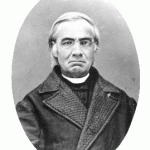What happened 171 years ago today certainly had a huge impact not only on the Catholic Church in Indiana, but on the State of Indiana and the American Church and country!
171 years ago today a band of Religious men left the shores of their native France headed for the wilds of Indiana.  Their final location wasn’t really known at this time. The second Bishop of Vincennes, Celestine de la Hailandiere, was waiting for their arrival.
Their final location wasn’t really known at this time. The second Bishop of Vincennes, Celestine de la Hailandiere, was waiting for their arrival.
On this day, August 8, 1841 Father Edward Sorin and a band of Holy Cross Brothers left LeHavre, France on the ship “Iowa” headed for New York and ultimately, Vincennes and Notre Dame du Lac.
Initially, Bishop Hailandiere tried to interest Fr. Sorin and his band in land that was owned in St. Francisville, Illinois. Sorin nixed that and then agreed to build his boys school in what was known as “Black Oak Ridge”,  which is now the area near Montgomery in Daviess County. This arrangement apparently went sour over time and Sorin chose to take up the Bishop’s other offer to settle on the land that had been owned by Fr. Stephen Badin, the first priest ordained in the United States, who worked among the Native Americans in the area.
which is now the area near Montgomery in Daviess County. This arrangement apparently went sour over time and Sorin chose to take up the Bishop’s other offer to settle on the land that had been owned by Fr. Stephen Badin, the first priest ordained in the United States, who worked among the Native Americans in the area.
Fr. Gorman writes:
Curiously, the bishop first offered Sorin the property at St. Francisville, accompanying him there to inspect it. Sorin, having rejected this offer, went
with Delaune to St. Peter’s which he agreed to accept immediately and the Brothers occupied the buildings on October l, 1841. On the site, in the middle
of a forest, was a little chapel with a sacristy and room for the priest, and, two log cabins, one used for a kitchen and the other for a school. One of the
latter, “a log house open to all the winds” and with extremely poor furnishings became the first mother house of Holy Cross in America. Sorin’s task, as outlined
by the bishop was to care for the Catholics within a five mile radius of St Peter’s with the missions of St. Patrick, St. Mary and Mt. Pleasant; to build a school for boys and to construct a novitiate for priests… Sorin began his pastoral labor. About a week after their establishment a notice appeared in a Washington paper that the Brothers of St. Joseph were ready to receive students and the Catholic almanac for 1842 contained a similar announcement.Sorin caught the idea which he was to hold with steady tenacity throughout his life – the establishment of a college. This is clearly indicated in an advertisement inserted in the Catholic almanac for 1842 which probably came to the attention of the bishop in the late summer of 1842. De la Hailandiere
summoned Sorin to Vincennes and, follling his policy of prohibiting competitive institutions, forbade the establishment of a college at St. Peter’s because St. Gabriel’s in Vincennes could not make ends meet. This, however, was only the culmination of a series of disagreements dating from the original misunderstanding about financing the foundation of Holy Cross. After several fruitless interviews, the bishop, in October, 1842, suggested the establishment of a college on Badin’s old property near South Bend. In spite of the difficulties which the bishop said were greater than he faced at St. Peter’s, Sorin, with the consent of the Brothers, accepted the proposal which had two obvious advantages: they would become owners and they would be so far from Vincennes that there would be comparatively little interference with their plans. 1
Thus the beginning of today’s University of Notre Dame.
- Fr. Robert Gorman, Unpublished History of the Catholic Church in Indiana[↩]